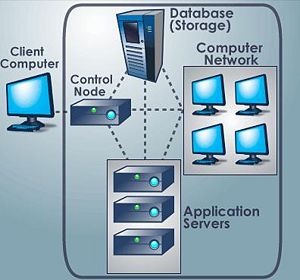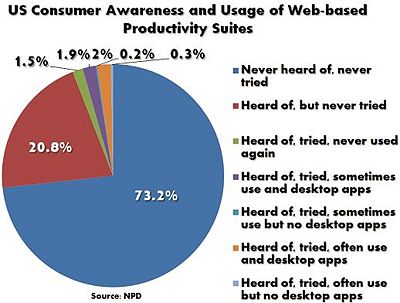Online document services
Besides, many other Eduzendium articles welcome your collaboration! |
Technology is analogous to a coin, it has two faces to it. Every little technology has a major story to tell us about its advantages and disadvantages. Especially in this era of innovation, witnessing advancements in technology have become as common as witnessing the sun rise everyday morning. What was popular yesterday is obsolete today and what is popular today will be obsolete tomorrow.
Web-based applications
Web-based application is a technology that has taken over the Internet world with a storm. Web-based applications are programs that run on Web servers and use Web pages as the user interface. [1] These applications can be accessed at the same time by multiple users. They use HTTP as its primary communications protocol and deliver web-based information in HTML. [2]
Examples of Web-based applications
* E-Mail * Online Maps * Online Banking * Instant Messaging * Online Reservation * Online Document Services and many more …
These applications are most commonly used in the day-day life of many internet users.
Principle of Online Document Service
Online document Service is made possible to the end-user based on the principle of cloud computing. Cloud Computing is a computing paradigm in which tasks are assigned to a combination of connections, software and services accessed over a network. The combination of network connections, software and services is called the cloud. Users connect to the cloud as and when they require the resource i.e the application they require. This is made possible by a large-scale distributive computing and server virtualization software's.
Cloud computing can be visualized as a networked computer system that harnesses the resources of several servers to complete tasks and store data. The user has to run the cloud computing system’s interface software, which can be as simple as a web-browser. The responsibility of storage and processing data falls to the network cloud and not on the individual user. This decreases user’s hardware and software requirements. Hence in cloud computing, the network is referred to as the super-computer.
What is online document service?
Online document service (ODS) offers the user with the ability to store, read, write and share their word documents, spreadsheets and presentations online. These documents are available anywhere and anytime to the user where he/she can access Internet.
Online document services act as collaborative tools, much like the way Wiki's do. But it is important to understand that both of them deserve a separate categorization, beyond their both being services in convergence of communications. Some of the points of distinction are:
- The main principle behind ODS is not authorship.
- An ODS involves editing contents of a document as opposed to editing the contents of a website.
- The primary purpose of an ODS is not to act as a knowledge repository or an encyclopaedia.
- An ODS has moderated collaboration.
Advantages of Online Document Service
Online document service have the following advantages when compared to the already available off-line document service providers (products):
- No software installation
- Operating System independent
- No ongoing or upfront expenses
- No up-grading(software) hazels
- No special hardware requirements
- Concurrent editing
- Ease of sharing
Online Document Service Providers
History
Oct, 2003 A small company in Cupertino, created ThinkFree, an office suite that is tightly linked with an online file storage service called CyberdrivePlus.
Jun, 2005 Adobe made its name on the Web by created a Web-based word processor application that called Buzzword.
Aug, 2005 Upstartle, a software company launched Writely, a web-based word processor.
Sep, 2005 AdventNet, a company focusing on building affordable software for businesses, launched Zoho.
Mar, 2006 Google announced that it had acquired Upstartle.
Jun, 2006 Google launched Spreadsheets.
Feb, 2007 Google Docs was made available to Google Apps users.
Mar, 2008 Zoho announced that Zoho Writer supports both online and offline access from Internet Explorer Mobile (IE Mobile).
Features
- Users can create, import and export documents.
- Users can publish their work as a webpage.
- Users can share and edit documents by inviting collaborators.
- The web-application keeps a record of recent changes made to a document by collaborators.
- The changes made to the document are visible in real-time.
- Owner can exercise access control by assigning permissions to collaborators.
Comparison of Features [3]
| Features | Zoho | Google Docs | ThinkFree Online | Adobe Buzzword |
|---|---|---|---|---|
| Yes | Yes | Yes | Yes | |
| 1GB of storage | Unlimited Storage | 1GB of storage | Unlimited Storage | |
| 10MB | 500K, plus up to 2MB per embedded image | 4MB | 10MB | |
| Docs, Spreadsheets, Presentations | Docs, Spreadsheets, Presentations | Docs, Spreadsheets, Presentations | Docs | |
| Yes | Yes | Yes | Yes | |
| 19 | 11 | 134 | 7 | |
| Yes | Yes | No | Yes | |
| Yes, only Roman alphabets | Yes, only Roman alphabets | Yes, Roman, Chinese, Japanese and Korean alphabets | No | |
| Ajax | Ajax | Java, Ajax | Flash | |
| Yes | No | Yes | No | |
| No | No | Yes | Yes |
Version control
Most of the times when you are editing a document, it goes through various revisions over a period of time. What if after numerous edits and saves, one day your mind reverts and you want to go back to the older version. Version control saves you the hassle of going back to square one and having to rewrite it all over again.
Version Control is an integral part of ODS. Changes to each document are usually identified by incrementing an associated number, called the revision number. Either simply increment numbers for each edit (v1,v2,v3, etc.) or denote major/minor revision number ((v1_0, v1_1, v1_2, v1_3, v2_0, etc.) or include dates ((v2008-07-01, v2008-07-14, etc. )
The image(Example of Version Control) has different versions of the same image. If the first image is stored as image.v1_0, the corresponding edits can be saved as image.v1_1,image. v1_2, image.v1_3 and image.v1_4. The user to get back to the original image from image.v1_, can do so by simply using the saved image.v1_0 instead of undoing the edits to get back to image.v1_0 from image.v1_4. Thus version control provides the user the flexibility to edit various versions of a particular file.
There are various version control methods : SCCS( source code control system), RCS(revision control system), CVS(concurrent versions system) , SVN(subversion), Perforce etc.
Each ODS has its own version control method. For example, Perforce is the version control system in use at Google.
Disadvantages
Though online document service provides users with rich experience and advantages, there are certain limitations users come across
- File size restriction
- Total dependency on network connection
- Poorly developed import/export features
- Not advisable for top-secret or proprietary files
These services at the present offered for free. If the online document service providers begin to charge the users for a fee for the services provided, the user will have to bare the fee to continue using his/her documents.
Future Development
We can anticipate the following enhancements to be available to the online document service users
- Support for international characters such as Chinese, Japanese and so on.
- Support for various mobile platform.
- Support for more document types, such as Visio.
- Support for Speech recognition.
Competition and Market
Off-line service providers are the principal competitors for online document service prvoiders.
Moreover, the latest US Consumer Awareness survey has found that three-fourth of the American population have never heard of online document services. If the awareness increases, the popularity of these services are sure to make an impact on the use of off-line document services.
See also Google_docs_vs._MS_word
Reference
- ↑ Reviews "The Other Road Ahead"
- ↑ Reviews "Business Dictionary.com"
- ↑ Reviews "Type and travel: Web-based word processors"




